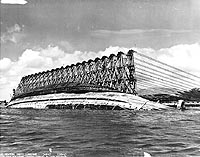
The righting and refloating of the capsized battleship Oklahoma was the largest of the Pearl Harbor salvage jobs, and the most difficult. Since returning this elderly and very badly damaged warship to active service was not seriously contemplated, the major part of the project only began in mid-1942, after more immediately important salvage jobs were completed. Its purpose was mainly to clear an important mooring berth for further use, and only secondarily to recover some of Oklahoma's weapons and equipment.
The first task was turning Oklahoma upright. During the latter part of 1942 and early 1943, an extensive system of righting frames (or "bents") and cable anchors was installed on the ship's hull, twenty-one large winches were firmly mounted on nearby Ford Island, and cables were rigged between ship and shore. Fuel oil, ammunition and some machinery were removed to lighten the ship. Divers worked in and around her to make the hull as airtight as possible. Coral fill was placed alongside her bow to ensure that the ship would roll, and not slide, when pulling began. The actual righting operation began on 8 March and continued until mid-June, with rerigging of cables taking place as necessary as the ship turned over.
To ensure that the ship remained upright, the cables were left in place during the refloating phase of the operation. Oklahoma's port side had been largely torn open by Japanese torpedos, and a series of patches had to be installed. This involved much work by divers and other working personnel, as did efforts to cut away wreckage, close internal and external fittings, remove stores and the bodies of those killed on 7 December 1941. The ship came afloat in early November 1943, and was drydocked in late December, after nearly two more months of work.
Once in Navy Yard hands, Oklahoma most severe structural damage was repaired sufficiently to make her watertight. Guns, some machinery, and the remaining ammuniton and stores were taken off. After several months in Drydock Number Two, the ship was again refloated and moored elsewhere in Pearl Harbor. She was sold to a scrapping firm in 1946, but sank in a storm while under tow from Hawaii to the west coast in May 1947.
This page features views related to the salvage of USS Oklahoma following the Japanese attack on Pearl Harbor.
For other images related to the salvage of USS Oklahoma,
see:
For views of USS Oklahoma during and shortly after
the Pearl Harbor attack, see:
For other views of the salvage of ships sunk or severely
damaged in the Pearl Harbor raid, see:
| If you want higher resolution reproductions than the Online Library's digital images, see: "How to Obtain Photographic Reproductions." |
Click on the small photograph to prompt a larger view of the same image.
|
Photo #: NH 84002 Pearl Harbor, Oahu, Territory of Hawaii View looking northward, with the Navy Yard industrial area in the foreground and the Marine Barracks in the lower right, 28 July 1942. Ford Island is at left, with USS Oklahoma and USS Arizona under salvage nearby. USS San Diego is in the upper center. USS West Virginia is in Drydock Number One, in the lower left, and USS California is alongside the wharf at the extreme right. Cruisers alongside the pier in right center are Northampton (left) and Pensacola. Submarines alongside 1010 Dock, just beyond Drydock # 1, are Trout, Pollack, Dolphin and Cachalot. Note camouflage on many of the Navy Yard's buildings. Courtesy of the Naval Historical Foundation. Collection of The Honorable James V. Forrestal. Official U.S. Navy Photograph, from the collections of the Naval History and Heritage Command. Online Image: 146KB; 740 x 600 pixels |
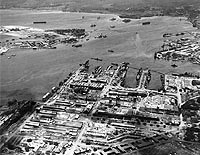 |
|
Photo #: NH 83994 Under Secretary of the Navy James V. Forrestal (left) With Rear Admiral William R. Furlong (right), Commandant of the Pearl Harbor Navy Yard, and another officer, on board the capsized hull of USS Oklahoma (BB-37), at Pearl Harbor on 6 September 1942. The ship was then in the early stages of salvage. Note the two battleships in the background, moored alongside Ford Island. They are Pennsylvania (BB-38), in center, and either Maryland (BB-46) or Colorado (BB-45). Courtesy of the Naval Historical Foundation. Collection of The Honorable James V. Forrestal. Official U.S. Navy Photograph, from the collections of the Naval History and Heritage Command. Online Image: 94KB; 740 x 625 pixels |
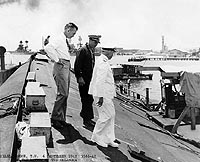 |
|
Photo #: NH 63920 Salvage of USS Oklahoma (BB-37), 1942-44 Ductwork installed to ventilate the capsized battleship's starboard side blister during salvage work. Photographed 11 December 1942, as the ship was being prepared for righting. Note the lugs welded to the blister side, to which the righting cables will be attached. Official U.S. Navy Photograph, from the collections of the Naval History and Heritage Command. Online Image: 141KB; 740 x 615 pixels |
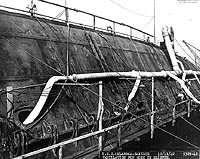 |
|
Photo #: 80-G-276601 Photographer's Mate 3rd Class T.E. Collins After photographing the oil and mud smeared interior of the capsized USS Oklahoma (BB-37) while she was under salvage at Pearl Harbor, 18 January 1943. He entered the ship through Number Four Air Lock, where pressure was raised to ten (lb.?) per square inch. An oxygen mast had to be worn at all times. Note his mask, tank suit, boots, gloves, and camera. Official U.S. Navy Photograph, now in the collections of the National Archives. Online Image: 110KB; 595 x 765 pixels Reproductions of this image may also be available through the National Archives photographic reproduction system. |
 |
|
Photo #: NH 63916 USS Oklahoma (BB-37) The capsized battleship is rotated upright, while under salvage at Pearl Harbor, Hawaii, on 8 March 1943. This view looks forward, with the ship in the 130 degree position. Her starboard deck edge is just rising from the water. U.S. Naval History and Heritage Command Photograph. Online Image: 124KB; 740 x 605 pixels |
 |
|
Photo #: NH 63915 USS Oklahoma (BB-37) Commencement of righting operations on the capsized battleship, at Pearl Harbor, 8 March 1943. Photographed from Ford Island, where several large winches and tackle anchors were emplaced to pull Oklahoma upright. Official U.S. Navy Photograph, from the collections of the Naval History and Heritage Command. Online Image: 132KB; 740 x 600 pixels |
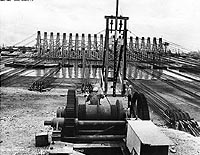 |
|
Photo #: 80-G-410534 USS Oklahoma (BB-37) Ship righted to about 30 degrees, on 29 March 1943, while she was under salvage at Pearl Harbor. She had capsized and sunk after receiving massive torpedo damage during the 7 December 1941 Japanese air raid. Ford Island is at right and the Pearl Harbor Navy Yard is in the left distance. Official U.S. Navy Photograph, now in the collections of the National Archives. Online Image: 118KB; 740 x 605 pixels Reproductions of this image may also be available through the National Archives photographic reproduction system. |
 |
|
Photo #: 80-G-410533 USS Oklahoma (BB-37) Ship righted to about 30 degrees, on 29 March 1943, while she was under salvage at Pearl Harbor. She had capsized and sunk during the 7 December 1941 Japanese air raid. Naval Air Station Ford Island is in the background. Official U.S. Navy Photograph, now in the collections of the National Archives. Online Image: 113KB; 740 x 600 pixels Reproductions of this image may also be available through the National Archives photographic reproduction system. |
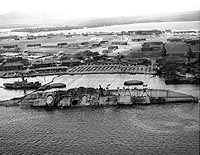 |
For other images related to the salvage of USS Oklahoma,
see:
For views of USS Oklahoma during and shortly after
the Pearl Harbor attack, see:
For other views of the salvage of ships sunk or severely
damaged in the Pearl Harbor raid, see:
NOTES:
| If you want higher resolution reproductions than the Online Library's digital images, see: "How to Obtain Photographic Reproductions." |
Page made 31 December 2000
Coding updated 23 April 2009